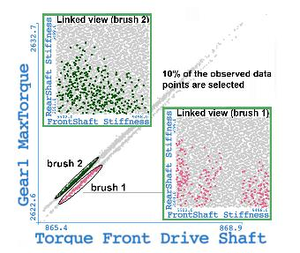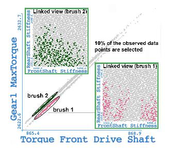Information
- Publication Type: Journal Paper with Conference Talk
- Workgroup(s)/Project(s):
- Date: 2016
- Journal: Computer Graphics Forum (2016)
- Volume: 35
- Number: 3
- Location: EUROVIS 2016
- Pages: 251 – 260
Abstract
Until now a lot of visual analytics predominantly delivers qualitative results—based, for example, on a continuous color map or a detailed spatial encoding. Important target applications, however, such as medical diagnosis and decision making, clearly benefit from quantitative analysis results. In this paper we propose several specific extensions to the well-established concept of linking&brushing in order to make the analysis results more quantitative. We structure the brushing space in order to improve the reproducibility of the brushing operation, e.g., by introducing the percentile grid. We also enhance the linked visualization with overlaid descriptive statistics to enable a more quantitative reading of the resulting focus+context visualization. Addition- ally, we introduce two novel brushing techniques: the percentile brush and the Mahalanobis brush. Both use the underlying data to support statistically meaningful interactions with the data. We illustrate the use of the new techniques in the context of two case studies, one based on meteorological data and the other one focused on data from the automotive industry where we evaluate a shaft design in the context of mechanical power transmission in cars.Additional Files and Images
Weblinks
No further information available.BibTeX
@article{Groeller_2016_P2,
title = "Towards Quantitative Visual Analytics with Structured
Brushing and Linked Statistics",
author = "Sanjin Rados and Rainer Splechtna and Kresimir Matkovic and
Mario Duras and Eduard Gr\"{o}ller and Helwig Hauser",
year = "2016",
abstract = "Until now a lot of visual analytics predominantly delivers
qualitative results—based, for example, on a continuous
color map or a detailed spatial encoding. Important target
applications, however, such as medical diagnosis and
decision making, clearly benefit from quantitative analysis
results. In this paper we propose several specific
extensions to the well-established concept of
linking&brushing in order to make the analysis results more
quantitative. We structure the brushing space in order to
improve the reproducibility of the brushing operation, e.g.,
by introducing the percentile grid. We also enhance the
linked visualization with overlaid descriptive statistics to
enable a more quantitative reading of the resulting
focus+context visualization. Addition- ally, we introduce
two novel brushing techniques: the percentile brush and the
Mahalanobis brush. Both use the underlying data to support
statistically meaningful interactions with the data. We
illustrate the use of the new techniques in the context of
two case studies, one based on meteorological data and the
other one focused on data from the automotive industry where
we evaluate a shaft design in the context of mechanical
power transmission in cars.",
journal = "Computer Graphics Forum (2016)",
volume = "35",
number = "3",
pages = "251--260",
URL = "https://www.cg.tuwien.ac.at/research/publications/2016/Groeller_2016_P2/",
}


 image
image paper
paper
